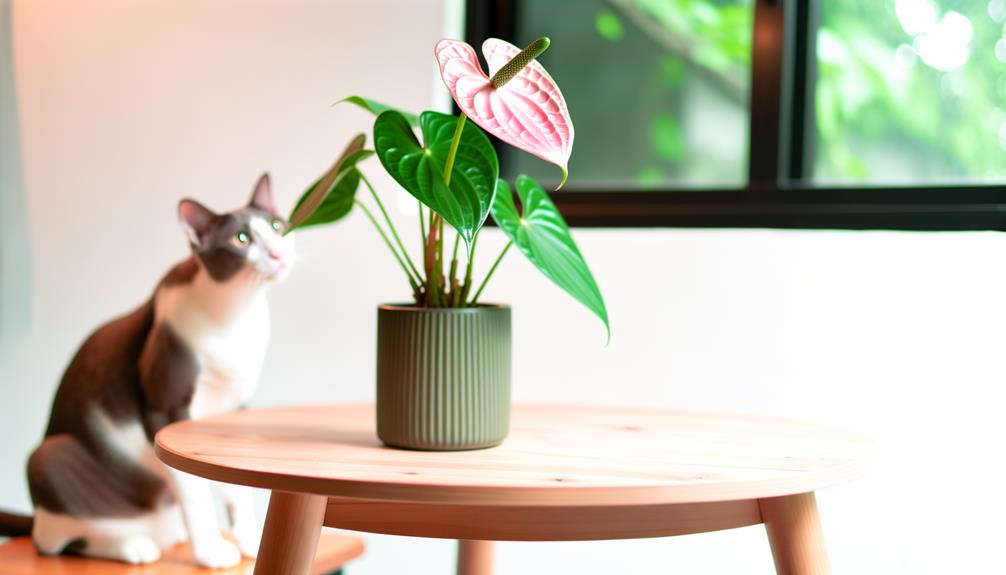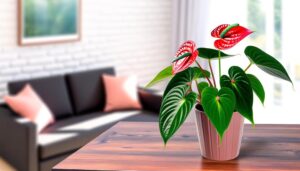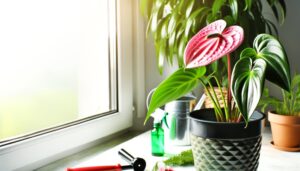Pink Anthurium Safety for Cats
Pink Anthuriums, although visually appealing, are toxic to cats due to calcium oxalate crystals. If your cat ingests any part of this plant, they might experience drooling, vomiting, and severe oral irritation.
Immediate veterinary care is critical to prevent complications. To secure your cat's safety, replace Pink Anthuriums with non-toxic alternatives like spider plants or Boston ferns.
Monitor your cat closely for signs of distress and educate household members about the risks. By doing so, you can maintain a safe environment for your feline friend.
Learn more about prevention and treatment to keep your cat healthy and content.

Key Takeaways
- Pink Anthuriums contain calcium oxalate crystals, toxic to cats and can cause severe symptoms like drooling and vomiting.
- Ingestion of Pink Anthurium leads to immediate oral irritation and gastrointestinal distress in cats.
- Prompt veterinary care is crucial if a cat ingests Pink Anthurium to prevent severe complications.
- Replace Pink Anthurium with non-toxic alternatives like spider plants and Boston ferns to ensure cat safety.
- Educate household members on the risks of Pink Anthurium to cats and ensure toxic plants are out of reach.
Understanding Pink Anthuriums
Pink Anthuriums, renowned for their vibrant and exotic appearance, are a popular choice among indoor plants. You'll notice their heart-shaped leaves and striking pink spathes make them visually appealing. These plants thrive in humid environments and require indirect light to thrive. When cared for properly, they can bloom year-round, adding a touch of elegance to your home.
You should water them regularly but avoid overwatering, as they prefer moist, well-drained soil. Regular misting can help maintain the humidity they need. Additionally, they benefit from monthly feeding with a balanced, water-soluble fertilizer.
Toxic Components
You need to be aware that Pink Anthuriums contain calcium oxalate crystals, which are highly toxic to cats.
Ingestion can cause severe symptoms such as drooling, pawing at the mouth, and vomiting.
If your cat shows any signs of these symptoms, seek immediate veterinary care.
Calcium Oxalate Crystals
Ingesting calcium oxalate crystals from anthurium plants can cause severe oral irritation and difficulty swallowing in cats. These needle-like crystals embed themselves in your cat's mouth, tongue, and throat, creating significant discomfort.
You need to be mindful of the following crucial points:
- Microscopic Structure: Calcium oxalate crystals are minuscule, sharp structures that penetrate soft tissues.
- Immediate Reaction: Upon ingestion, your cat may display signs of distress almost instantly.
- Potential for Escalation: Without timely intervention, symptoms can worsen, leading to more severe health issues.
Understanding the dangers posed by these crystals is crucial for protecting your feline companion's well-being. Always monitor your cat and make sure they don't have access to anthurium plants.
Ingestion Symptoms
Recognizing the symptoms of ingestion is vital to address the toxic components of anthurium plants promptly. If your cat chews on a pink anthurium, they may show signs of distress almost immediately. Look for drooling, pawing at the mouth, and difficulty swallowing—these are early indicators.
Vomiting and a decreased appetite can also occur. The primary toxic component, calcium oxalate crystals, can cause intense oral irritation and swelling. Pay attention to excessive drooling and vocalization, as these symptoms suggest significant discomfort. You might also notice your cat shaking its head frequently.
Don't ignore these signs; they signify that your cat has ingested something harmful and needs your attention. Early recognition can make all the difference in managing these toxic effects.
Immediate Veterinary Care
When your cat shows signs of anthurium ingestion, immediate veterinary care is vital to mitigate the toxic effects. Anthurium plants contain calcium oxalate crystals, which can cause severe irritation in your cat's mouth, throat, and gastrointestinal tract. Prompt action is necessary to reduce discomfort and prevent complications.
Identify Symptoms: Look for drooling, pawing at the mouth, and vomiting.
Contact Veterinarian: Call your vet immediately to describe the symptoms and get advice.
Follow Treatment: Your vet might recommend bringing your cat in for an examination and potential treatments like IV fluids or medications to soothe pain and inflammation.
Don't wait; quick intervention can make all the difference in your cat's recovery and well-being.
Symptoms of Ingestion
If your cat ingests pink anthurium, you may observe immediate mouth and throat irritation.
Gastrointestinal distress, such as vomiting and diarrhea, often follows.
Additionally, watch for any behavioral changes, as these can indicate discomfort or more severe reactions.
Mouth and Throat Irritation
Ingesting pink anthurium can cause immediate irritation in a cat's mouth and throat, leading to symptoms such as drooling, difficulty swallowing, and pawing at the mouth. Your cat's discomfort is often obvious and distressing to witness. It's vital to recognize the signs quickly to mitigate further harm.
- Drooling: Excessive salivation is a primary indicator of oral irritation.
- Difficulty Swallowing: Your cat may struggle to swallow, showing signs of pain or choking.
- Pawing at Mouth: This behavior signifies an attempt to alleviate the irritation.
These symptoms demand prompt action. Remove any remaining plant material from your cat's reach and consult your veterinarian immediately.
Awareness and swift intervention can prevent more severe complications, ensuring your cat's well-being.
Gastrointestinal Distress Signs
Cats that ingest pink anthurium often exhibit gastrointestinal distress, characterized by symptoms such as vomiting, diarrhea, and abdominal pain. You might notice your cat retching frequently or expelling food shortly after eating.
Diarrhea can be severe, leading to dehydration if not addressed promptly. Abdominal pain is often indicated by your cat's reluctance to be touched, a hunched posture, or persistent crying. It's vital to monitor for these signs closely, as they indicate that the ingested plant is causing significant internal discomfort.
Immediate veterinary attention is recommended to alleviate symptoms and prevent further complications. Administering fluids and supportive care can help your cat recover more swiftly. Always keep pink anthurium plants out of your cat's reach to guarantee their safety.
Behavioral Changes Noted
You may notice lethargy, increased aggression, or unusual hiding behavior in your cat after it has ingested pink anthurium. These behavioral changes are vital signals that something is wrong.
Keep an eye out for the following symptoms:
- Restlessness or pacing: Your cat may appear unable to settle.
- Excessive drooling: This can indicate oral irritation or discomfort.
- Vocalization: Increased meowing or yowling may signal distress.
It's essential to observe these signs closely. Early detection can make a significant difference in your cat's health outcome. If you notice any of these behaviors, consult your veterinarian immediately. Quick intervention could prevent more severe complications.
Always keep an eye on your cat around potentially toxic plants like pink anthurium.
Immediate Actions
If your cat exhibits signs of having consumed pink anthurium, promptly eliminate any plant material from its mouth and reach out to your veterinarian.
Don't rinse your cat's mouth as this may worsen the irritation. Instead, closely observe your cat for signs like excessive saliva, scratching at the mouth, throwing up, or difficulty swallowing.
Keep your cat relaxed and in a safe environment, reducing stress. Collect any remaining fragments of the plant to aid your veterinarian in identifying the toxin. Record the time of consumption and any symptoms shown.
Taking quick action can have a significant impact on your cat's well-being. Always have emergency contact details for your vet easily accessible to guarantee swift response.
Veterinary Treatment
Veterinarians will typically begin treatment by evaluating the severity of the symptoms and may administer medications to alleviate pain and reduce inflammation.
Your cat's care will often include:
- Intravenous fluids: To prevent dehydration and support kidney function.
- Activated charcoal: To reduce toxin absorption in the stomach.
- Anti-nausea medications: To control vomiting and provide comfort.
These steps are essential in stabilizing your cat. The veterinarian might also conduct blood tests to check for any systemic effects of the toxin.
Don't delay in seeking professional help, as prompt veterinary care can make a significant difference in your cat's recovery. Trust your vet to guide you through managing this delicate situation with expertise and compassion.
Safer Plant Alternatives
You should consider replacing your Pink Anthurium with non-toxic houseplants to guarantee your cat's safety.
Pet-friendly greenery like spider plants, Boston ferns, and orchids are excellent alternatives.
These options provide the aesthetic appeal without the risk of toxicity.
Non-Toxic Houseplants
Many houseplants are safe for cats, providing peace of mind and a beautiful home environment without the risk of toxicity. Selecting non-toxic houseplants is essential to safeguarding your feline friend while enhancing your living space.
Consider these safe options:
- Spider Plant: Known for its air-purifying qualities, it's both attractive and harmless to cats.
- Boston Fern: This lush, green plant offers beauty and is cat-friendly, ensuring no toxic reactions.
- Areca Palm: Adds a tropical touch to your home without posing any danger to your pet.
Pet-Friendly Greenery
Selecting pet-friendly greenery guarantees your home remains a safe haven for your cat while still providing the aesthetic benefits of indoor plants. Consider spider plants, which are non-toxic and easy to care for.
Boston ferns are another excellent choice, offering lush foliage without posing any risk to your feline friend. You can also opt for baby's tears, a charming plant that thrives in low light and won't harm your cat if ingested.
Finally, cast iron plants are hardy and non-toxic, making them ideal for households with curious pets. By choosing these alternatives, you're ensuring a harmonious living space where your cat can explore freely without the danger of toxic plants.
This proactive approach keeps your pet's well-being front and center.
Cat-Proofing Your Home
Securing your home for cats involves identifying and eliminating potential hazards, such as toxic plants like Pink Anthurium. Start by thoroughly inspecting every room. Remove or securely place any harmful items out of your cat's reach. Focus on creating a secure environment where your feline friend can explore without risk.
Replace Toxic Plants: Swap hazardous plants with cat-safe alternatives.
Secure Loose Items: Prevent accidental ingestion by storing small objects properly.
Cover Electrical Cords: Use cord protectors to avoid chewing hazards.
Taking these steps guarantees your home is a sanctuary for your cat. Remember, a vigilant approach to cat-proofing not only protects your pet but also provides peace of mind, knowing your beloved companion is safe.
Monitoring Your Cat
Once your home is secure, consistently monitor your cat's behavior to promptly identify any signs of distress or exposure to potential hazards. Observe for symptoms like vomiting, drooling, or difficulty breathing. Note changes in appetite or activity levels. Below is a table summarizing symptoms and actions:
| Symptom | Description | Action |
|---|---|---|
| Vomiting | Frequent, excessive | Contact vet immediately |
| Drooling | Excessive saliva production | Rinse mouth, seek advice |
| Breathing Issues | Labored, wheezing | Emergency vet visit |
| Lethargy | Unusual tiredness | Monitor closely, consult |
| Loss of Appetite | Refusal to eat/drink | Observe, consult if persistent |
Regularly check your cat's environment and make sure they're not gnawing on plants. Quick intervention can minimize risks.
Educating Family Members
It's important to inform all family members about the potential risks of pink anthuriums to cats to make sure everyone's vigilant in preventing exposure.
Ensuring that everyone in the household understands the dangers can prevent accidental ingestion and potential health issues for your feline friends.
Here are some key points to cover:
- Toxicity: Explain that pink anthuriums contain calcium oxalate crystals, which can cause severe irritation if ingested.
- Symptoms: Educate them on signs of poisoning, such as drooling, vomiting, and difficulty swallowing.
- Prevention: Encourage everyone to keep these plants out of reach or consider choosing non-toxic alternatives.
Additional Resources
For further information on keeping your cat safe from pink anthurium toxicity, you can access a variety of resources designed to educate pet owners.
Begin with veterinary websites, which often provide detailed guides on toxic plants and safe alternatives. The ASPCA's website is another reliable resource, offering detailed lists of hazardous and non-harmful plants.
You can also consult pet care forums where experienced owners and vets share insights. Additionally, many local animal shelters and veterinary clinics provide pamphlets and workshops on pet safety.
Don't forget to check out books specifically addressing household toxins and pet health. By leveraging these resources, you ensure your feline friend remains safe and healthy in a home free of harmful threats.
Conclusion
In caring for your feline friend, it's important to be mindful of the hidden dangers around your home. Pink anthuriums, while beautiful, can lead to some rather unfortunate health issues for cats.
Stay vigilant—remove these plants, educate your family, and always monitor your pet's behavior.
Should your cat have an unpleasant encounter, swift action and veterinary care are vital.
By taking these steps, you're ensuring a safer and happier environment for your cherished companion.






